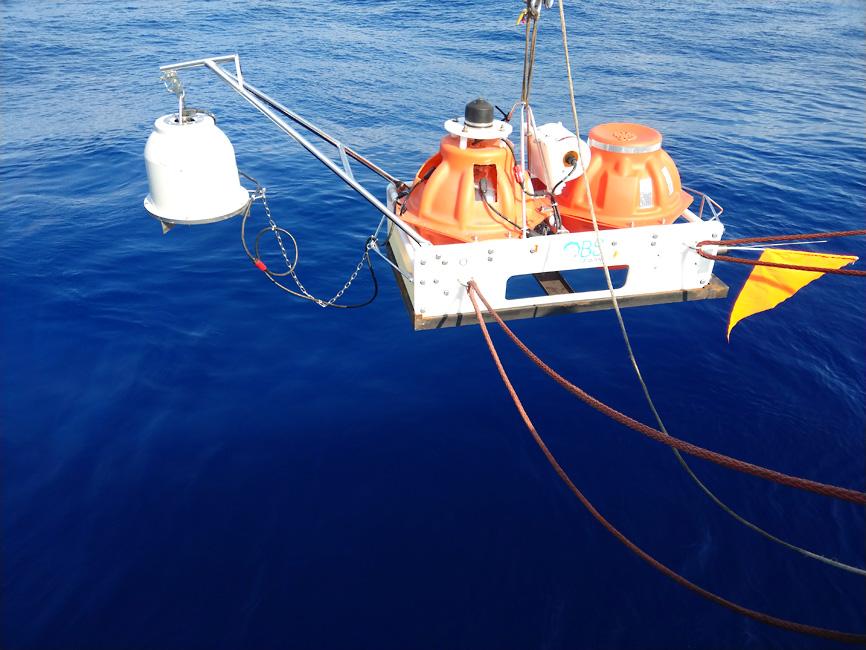Taiwan plans to join the US, Japan and South Korea to survey the Pacific tectonic plate with locally built ocean bottom seismometers (OBS) next year, which would allow scientists to chart new research areas, Academia Sinica Institute of Earth Sciences research fellow Kuo Ban-Yuan (郭本垣) said.
The opportunity arose after he led a team of Taiwanese researchers to deploy an OBS array in the Northern Okinawa Trough onboard the research vessel Legend (勵進) from 2018 to last year in collaboration with the Japan Agency for Marine-Earth Science and Technology and the University of the Ryukyus, Kuo told the Taipei Times on March 16.
Inaugurated in May 2018, the 2,629 tonne Legend is managed by the National Applied Research Laboratories’ Taiwan Ocean Research Institute (TORI).

Photo courtesy of Academia Sinica research fellow Kuo Ban-Yuan
It was the first time that Taiwanese and Japanese scientists had cooperated on research of this kind and scale within Japan’s exclusive economic zones, he said.
He thanked Taiwan-Japan Cultural and Economic Association honorary chairman Cheng Chi-Yao (鄭祺耀) and former Japanese representative to Taiwan Mikio Numata for their help, which made the voyages possible.
In September 2018, they deployed 35 OBSs in the trough and recovered 33 of them nine months later, Kuo said.
The survey found that earthquakes below the northern trough can happen at depths of up to 300km, deeper than a previous observation of nearly 200km, he said.
Once the team has published the first round of their findings, the OBS data would be made available on the Taiwan Earthquake Research Center or other platforms, he said.
Kuo said he is to lead a team to deploy an OBS array in the central Pacific Ocean in March next year, joining other academics from the US, Japan and South Korea to create the western wing of a Pacific array, which, when complete, would be made of more than 100 OBSs across the Pacific Plate — the world’s largest tectonic plate.
The Taiwanese team is to deploy 20 of the devices — 10 of them alongside ocean floor electro-magnetometers provided by the University of Tokyo — in an area where the crust is estimated to be 180 million years old — the oldest part of the Pacific Plate, Kuo said.
The seafloor between Guam and Hawaii is a “purer” area, with less volcanic activity and fewer crustal faults, allowing for observations of the fundamental workings of the lithosphere and asthenosphere, the top two layers of the Earth, he said.
The ocean is 5,000m deep there, he said.
Unlike satellites, which allow space-ground communications, marine geophysicists must recover the seismometers to get high-quality data, as frequent acoustic communication is too costly and not feasible, he said.
Despite the risks, more seafloor-based missions are needed, as land-based instruments have almost reached their limits, Kuo said.
The indigenous OBS development, which began in 2008, was led by National Sun Yat-sen University (NSYSU), TORI and Kuo’s lab, said TORI director-general Wang Chau-Chang (王兆璋), a former NSYSU Institute of Undersea Technology chairman.
The broadband seismometers can receive signals from nearly 20,000km away, Wang said.
They designed a leveling device to ensure that the seismic sensors sit stably regardless of unevenness on the seafloor and their high-energy-density lithium battery pack can last a year, he said.
In addition to the Taiwanese team, only certain laboratories in the US, the UK, Japan, Germany, France and China are capable of integrating an OBS’ hardware and software systems, he said.
Pusan National University in South Korea has purchased two from TORI, Wang said.
Developing more survey instruments instead of purchasing them from elsewhere is key to boosting research and industrial capacity, Kuo said.
As the nation is launching more research ships, domestic scientists have the opportunity to embark on bolder projects, he said, adding that hopefully the government would support more integrated Earth science projects.

South Korean K-pop girl group Blackpink are to make Kaohsiung the first stop on their Asia tour when they perform at Kaohsiung National Stadium on Oct. 18 and 19, the event organizer said yesterday. The upcoming performances will also make Blackpink the first girl group ever to perform twice at the stadium. It will be the group’s third visit to Taiwan to stage a concert. The last time Blackpink held a concert in the city was in March 2023. Their first concert in Taiwan was on March 3, 2019, at NTSU Arena (Linkou Arena). The group’s 2022-2023 “Born Pink” tour set a

CPBL players, cheerleaders and officials pose at a news conference in Taipei yesterday announcing the upcoming All-Star Game. This year’s CPBL All-Star Weekend is to be held at the Taipei Dome on July 19 and 20.

The Taiwan High Court yesterday upheld a lower court’s decision that ruled in favor of former president Tsai Ing-wen (蔡英文) regarding the legitimacy of her doctoral degree. The issue surrounding Tsai’s academic credentials was raised by former political talk show host Dennis Peng (彭文正) in a Facebook post in June 2019, when Tsai was seeking re-election. Peng has repeatedly accused Tsai of never completing her doctoral dissertation to get a doctoral degree in law from the London School of Economics and Political Science (LSE) in 1984. He subsequently filed a declaratory action charging that

The Hualien Branch of the High Court today sentenced the main suspect in the 2021 fatal derailment of the Taroko Express to 12 years and six months in jail in the second trial of the suspect for his role in Taiwan’s deadliest train crash. Lee Yi-hsiang (李義祥), the driver of a crane truck that fell onto the tracks and which the the Taiwan Railways Administration's (TRA) train crashed into in an accident that killed 49 people and injured 200, was sentenced to seven years and 10 months in the first trial by the Hualien District Court in 2022. Hoa Van Hao, a